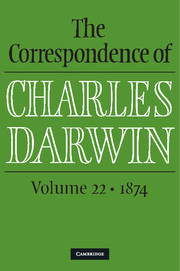Book contents
- Frontmatter
- Dedication
- Miscellaneous Frontmatter
- Contents
- List of illustrations
- List of letters
- Introduction
- Acknowledgments
- List of provenances
- Note on editorial policy
- Darwin/Wedgwood genealogy
- Abbreviations and symbols
- THE CORRESPONDENCE
- Appendixes
- I Translations
- II Chronology
- III Diplomas
- IV Presentation lists for Coral reefs 2d ed. and Descent 2d ed.
- V St G. J Mivart, G. H. Darwin, and the Quarterly Review
- Manuscript alterations and comments
- Biographical register and index to correspondents
- Bibliography
- Notes on manuscript sources
- Index
- Table of Relationship
IV - Presentation lists for Coral reefs 2d ed. and Descent 2d ed.
from Appendixes
Published online by Cambridge University Press: 05 July 2018
- Frontmatter
- Dedication
- Miscellaneous Frontmatter
- Contents
- List of illustrations
- List of letters
- Introduction
- Acknowledgments
- List of provenances
- Note on editorial policy
- Darwin/Wedgwood genealogy
- Abbreviations and symbols
- THE CORRESPONDENCE
- Appendixes
- I Translations
- II Chronology
- III Diplomas
- IV Presentation lists for Coral reefs 2d ed. and Descent 2d ed.
- V St G. J Mivart, G. H. Darwin, and the Quarterly Review
- Manuscript alterations and comments
- Biographical register and index to correspondents
- Bibliography
- Notes on manuscript sources
- Index
- Table of Relationship
Summary
The second edition of Coral reefs was published in late May or early June 1874 (letter from G. H. Darwin, 30 May 1874). The first edition of Coral reefs had been published in 1842; Darwin had approached the publisher, Smith, Elder & Co., in December 1873 about producing a new edition of the work (see Correspondence vol. 21, letter to Smith, Elder & Co., 17 December [1873]). The shortage of copies of the first edition is shown by Darwin's trouble finding a copy to correct; in the end he used Charles Lyell's copy (letter to Charles Lyell, [13 January 1874]). The proof-sheets were corrected by Darwin's eldest daughter, Henrietta Emma Litchfield; Emma Darwin worked on the revises, and an old family friend, Ellen Tollet, pronounced the first sheet ‘perfectly clear’, although Darwin lamented that the whole was ‘atrociously written’ (letters to H. E. Litchfield, 21 [March 1874] and 27 [March 1874]). Corrections were so heavy that Darwin offered to pay for any that Smith, Elder thought excessive (letter to Smith, Elder & Co., 27 March [1874]).
The second edition of Descent was published by John Murray as a single volume in November 1874 (letter from R. F. Cooke, 12 November 1874). The first edition had been published in two volumes in 1871, and there were reprints with corrections in the same year (see Correspondence vol. 19, Appendix IV). Darwin planned the revision in November 1873: he asked his second son, George Howard Darwin, to assist, carefully describing the work involved and proposing to pay him forty guineas (see Correspondence vol. 21, letter to G. H. Darwin, 20 November 1873). Darwin finished the task by the beginning of April, after above three months as hard work as he had ever had in his life, as he wrote to his publisher (letter to John Murray, 4 April 1874): he reckoned he had added forty to fifty pages to the first volume, although considerably less to the second (letter to R. F. Cooke, 8 April 1874). George Darwin's travels in Germany in June and July delayed the corrections (letter to R. F. Cooke, 17 June [1874]).
- Type
- Chapter
- Information
- The Correspondence of Charles Darwin , pp. 632 - 634Publisher: Cambridge University PressPrint publication year: 2015
- 22
- Cited by



